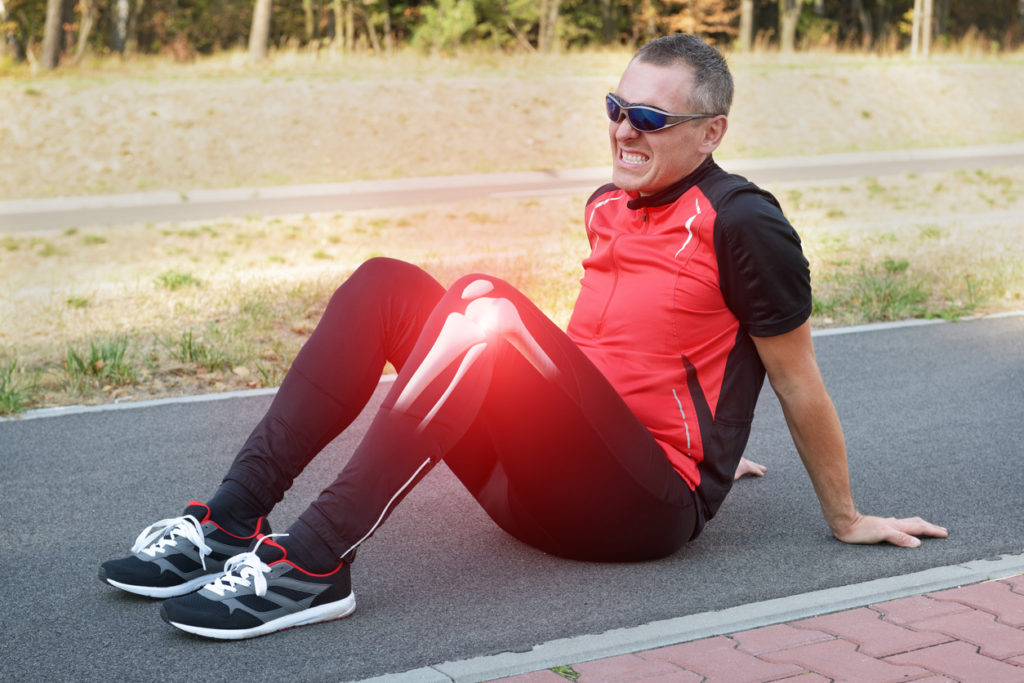Jump To
Injuries are common in many sports, particularly contact and/or high intensity sports. Some of the more common sports injuries include soft tissue injuries (such as hamstring or groin strains), joint injuries (such as knee, shoulder, ankle and elbow injuries), bone injuries (such as stress fractures) and head injuries (such as concussion).1
Regardless of the type of injury, appropriate recovery is very important.2 Ultimately, returning to sport too early or after an inadequate recovery will likely result in further damage.1
Sports injuries vary significantly in type and severity, and physical recovery programs should be tailored to a person’s individual needs. There are some general aspects of physical recovery, however, that are relevant to all injuries.3
Immediately following the injury, the first stage of physical recovery generally involves an ‘unloading’ phase. The key aspect of this phase is to protect the injured body part from activities that could potentially impair the healing process. Soft tissue injuries, such as hamstring or groin strains, require utilisation of the RICER protocol: Rest, Ice, Compression, Elevation and Referral.3 Joint injuries, such as shoulder, knee, elbow or ankle injuries, will generally require injury-specific treatment that will often involve a period of immobilisation.4
The middle stages of physical recovery generally aim to restore normal physiology. This involves increasing the demands on the body part – for example, via stretching and strengthening exercises – after healing has occurred.3
The final stage, called the ‘functional training’ stage, is to undergo recovery training that mimics the specific demands of the sport. For professional athletes, this stage usually involves highly technical physical techniques that generally require supervision by a sports physiotherapist3.
Get on top of your physical health
Find and instantly book affordable physios within Australia
The psychosocial well-being of anyone recovering from a sports injury should receive the necessary focus and attention from everybody involved in the recovery process. Evidence suggests that positive psychosocial responses to injury and recovery are associated with higher rates of returning to sport.5 Some key points that should be considered include:6
- Emotional responses to injury change over time. Players should have access to emotional and informational support throughout the recovery period. This support needs to be tailored to the players’ needs.
- Talking about the injury. Players should be encouraged to continually talk about and reflect on their injury and express their feelings in an open, non-judgemental environment.
- Frequent communication and interaction. Injured players want coaching staff and other players to regularly stay in touch.
- Task-orientated exercises. Keeping the athlete motivated by incorporating a variety of task-orientated exercises into recovery, can help promote willingness to adhere to the long-term program.
- Professional support. Players should have access to professional psychosocial support.
- Player education. Athletes should be educated about the psychosocial aspects of recovering from an injury, in order to help prepare the athlete to deal with potential emotional responses.
How sports physiotherapy can help
Sports physiotherapy, or sports injury physio, is a specialised field of physiotherapy that helps people deal with sports-related injuries and issues. Sports physiotherapists are specifically trained to facilitate athletes’ recovery programs in a holistic manner.7
Evidence suggests that early physiotherapy intervention after a sports injury has many benefits, including:8
- Achieving pain relief faster, through techniques such as joint mobility, massage and electrotherapy
- Improving scar tissue formation
- Returning to sport as quickly as possible
- Developing personalised exercise programs for the injured body part
- Improving performance and identifying any biomechanical faults that could be increasing the risk of injury.
A: Use HealthEngine to find and book your next Physiotherapist appointment. Click on the following locations to find a Physiotherapy clinic in your state or territory.
This article is for informational purposes only and should not be taken as medical advice. If in doubt, HealthEngine recommends consulting with a registered health practitioner.
References
Better Health Channel (online). Sports injuries [accessed 22 April 2019]. Available from: URL link
- Gatorade Sports Science Institute (online). Recovery techniques for athletes [accessed 22 April 2019]. Available from: URL link
- AFL (online). AFL community: Soft tissue injuries [accessed 22 April 2019]. Available from: URL link
- AFL (online). AFL community: Common upper limb sport injuries [accessed 23 April 2019]. Available from: URL link
- Ardern, C.L., Taylor, N.F., Feller, J.A. and Webster, K.E., 2013. A systematic review of the psychological factors associated with returning to sport following injury. Br J Sports Med, 47(17), pp.1120-1126. Available from: URL link
- AFL (online). AFL community: The Psychosocial reactions to injury [accessed 23 April 2019]. Available from: URL link
- Physio Works (online). What is Sports Physiotherapy? [accessed 24 April 2019]. Available from: URL link
- Physio Works (online). Sports Injury? What to do? When? [accessed 24 April 2019]. Available from: URL link
All content and media on the HealthEngine Blog is created and published online for informational purposes only. It is not intended to be a substitute for professional medical advice and should not be relied on as health or personal advice. Always seek the guidance of your doctor or other qualified health professional with any questions you may have regarding your health or a medical condition. Never disregard the advice of a medical professional, or delay in seeking it because of something you have read on this Website. If you think you may have a medical emergency, call your doctor, go to the nearest hospital emergency department, or call the emergency services immediately.









